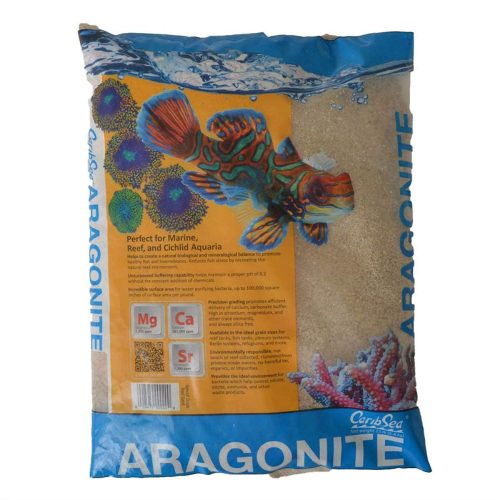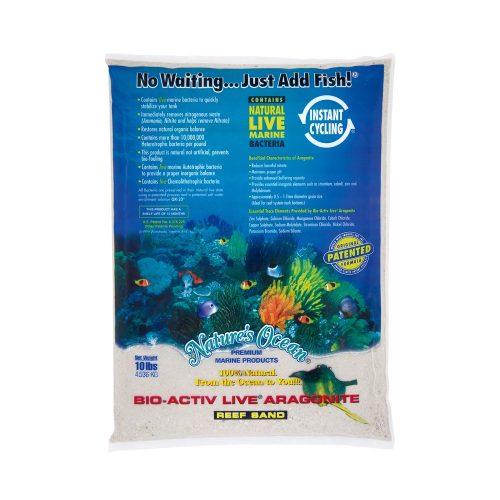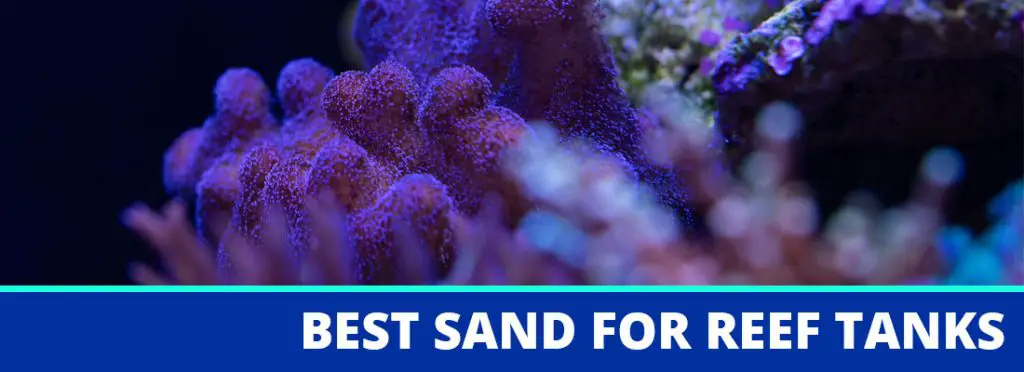The best reef tank is a happy, healthy environment where saltwater fish, corals, plants, and other critters thrive in live sand and properly balanced saltwater.
The best reef sand can offer great buffering capacity as well as provide the tank with the right healthy bacteria to keep everything thriving for years without ever having to be replaced.
Best Reef Sand Quick-Find Table
| Image | Product | |||
|---|---|---|---|---|
EDITOR'S CHOICE  | EDITOR'S CHOICE |
|
| VIEW LATEST PRICE |
 |
|
| VIEW LATEST PRICE | |
 |
|
| VIEW LATEST PRICE |
What is Live Sand?
If you’re a newer aquarist, you may be hearing the terms “live rock” and “live sand” and not really know what’s going on.
Live sand is traditionally a natural reef coral sand – though now may be some other substance – that comes populated with millions of beneficial bacteria.
The bacteria on the sand helps your aquarium dissolve organic wastes like nitrites, nitrates, and ammonia in saltwater aquariums.

Live sand should be paired with a high-quality protein skimmer to have the healthier reef tank possible.
Why the Right Sand is Important for Your Reef Tank
You do not technically have to have any sand in your tank. You could choose to maintain a bare bottom tank instead, but there are several reasons folks use live sand in their reef tanks.
Biological Filtration
One of the most important reasons you need live sand instead of dry sand for your reef aquarium is the natural biological filtration that live sand performs.
The substrate has living organisms that naturally do the work of filters – though you still need filters – to improve the health inside your tank.
Burrowing and Sand-Sifting Critters
A lot of fish, snails, crabs, worms, and others are burrowing and sand-sifting creatures that you may keep in your tank.
Shrimp, for example, burrow into live sand and eat the various tinier critters in there to snack on.
These creatures are happiest with a bed of live sand that provides them with a place to burrow and dine.
Denitrification
If you have a deep sand bed – six inches of sand or deeper – you will have a layer at the bottom where oxygen doesn’t reach. There are bacteria down here that remove nitrates from water.
These bacteria live in these oxygen-free zones in the sand and perform this denitrification for you, removing those unhealthy nitrates altogether.
Aesthetic Appeal
Of course, many aquarists include live sand in their reef tanks because it’s an attractive addition to the whole setup.
It helps your aquarium feel a bit more like a real reef and providing a solid visually dimension to the bottom of the tank.
Types of Reef Sand
There are a few common types of reef tank sand that you’ll want to consider for your reef tank.
Aragonite Sand
Probably the most popular sand type is the aragonite sand.
This is a fine grain product that looks the most like common sand you’d find on the beach.
It’s calcium carbonate, which is made of the same thing that common beach sand is made of.
Crushed Coral
Another popular option is literal crushed or sifted coral fragments.
This is a much larger substrate with particles often more the size of gravel. It usually looks like white or off-white stones.
Oolite
Also known as oolitic aquarium sand, oolite is your “fancy” sand that’s fine, spherical aragonite sand. The term comes from the formation process of the sand.
By definition, oolite sand has to be less than 2 millimeters in diameter. Oolite also only refers to the size and shape of the sand, rather than the material, so oolite could be hematite, dolomite, or even phosphate.
Reef Sand Colors
The final thing we’d like to think through is the colors of sand that may be available.
Generally speaking, color doesn’t affect anything other than aesthetics, so go with your preferences.
The exception is, of course, camouflage for certain creatures who like to hide in the sand – think cuttlefish and flounder.
- Natural/traditional colored sand
- White sand
- Black sand
- Pink sand

Anything with unnatural colors is going to be a questionable choice for your aquarium, so please avoid using these as the dyes may bleed into the water and kill your fish.
Reviews of the Best Reef Sand
We looked for the best live and dry reef sand to recommend for your reef tank.
Most options come from the same few trusted-brands, but you’ll find the differences are notable as the types of sand serve various functions.

The best-rated aragonite sand I’ve found anywhere is the Fiji Pink Arag-Alive option from Carib Sea.
This brand is a well-trusted option for almost any kind of saltwater and freshwater substrate around, so it’s not surprising that among real users, one of their products is the number one ranked on sites like Amazon.
The bacteria in this live sand is a combination of naturally occurring beneficial bacteria from the ocean and specially selected strains of marine bacteria for enhanced biological filtration.
The Arag-Alive options are specifically designed to compress new tank cycle time and suppress the initial ammonia spike from adding new sand and bacteria to a system causes.
So, if you’re in a hurry to get your aquarium up and running, Carib Sea Arag-Alive is the perfect option for you.
- Type of sand: Live aragonite
- Pounds of sand: 20-pounds
- Color: Light pink
- Size: Intermediate size grain
What We Loved
The incredible blend of ocean and marine strains of helpful bacteria makes all the difference in introducing new live sand into your reef tank.
The heterotrophic, chemolithotrophic, and autotrophic bacteria significantly reduce the cycling time for setting up a new tank and reduce waste more quickly than other strains.
The beautiful color is a like, warm pink that’s inviting and beachy without being too coarse looking. It’s small enough to be attractive but large enough that it doesn’t move easily in the tank.
The substrate never needs to be replaced. It works in conjunction with the natural bacteria in place that keeps your reef healthy.
The grain size is similar to what you’d find at the beach, so it’s a great choice for your sand-sifters and burrowing creatures like gobies.
What We Didn’t Love
In most cases, this live sand is more of a light beige than pink, so if you’re looking for that natural shade like you’d get in Bermuda, you may be disappointed.
You can blend it with other Arag-Alive colors to create a more ideal shade, if you prefer.
Our Verdict on the Carib Sea Arag-Alive Fiji Pink Sand
The Carib Sea Arag-Alive Fiji Pink Sand is a beautiful, warm shade of pink-tinged beige, beach-sized grains of aragonite sand.
It’s perfect for burrowing critters, comes with loads of the right bacteria to help reduce new tank syndrome and naturally improve the health of your tank.
All around, this is best live sand for reef tanks we could find anywhere and most folks agree.
>> Tap Here to Read More Reviews and See Today’s Price on Amazon.com <<

Since live sand is vital for a healthy aquarium, but it’s darn expensive, having a quality dry sand is a great option for fleshing out your reef tank sand needs. And Carib Sea has the best in dry sand options, as well.
The Dry Aragonite Special Grade Reef Sand is designed specifically to be combined with live reef sand as an acceptable filler to bridge the gap into an affordable aquarium substrate.
One of the things I like about the Special Grade Reef Sand from Carib Sea is that it’s specifically harvested from ocean beds to provide the most natural aquarium sand possible.
It blends perfectly with other Carib Sea live sands or various other dry sands to provide your aquarium with a deep bed of sand for diggers and sifters.
- Type of sand: Dry aragonite
- Pounds of sand: 15-pounds
- Color: Beige
- Size: 1.2-1.95 millimeter – reasonably fine grains
What We Loved
The Special Grade Reef Sand provides an incredibly natural, lower-cost reef sand for your aquarium that will feel like home to your tropical fish. It combines well with live sand for a deep sand bed.
It’s also a naturally beautiful sand that adds a warm beige hue to the bottom of the fish tank/
The sand is amazing at keeping the aquarium at a precise pH of 8.2 – as long as you take other precautions, as well – for the highly-specific needs of some fish.
What We Didn’t Love
The only negative comment I’ve seen on this sand is that it comes in just this one single style.
Unlike many of Carib Sea’s other sand offerings that have multiple colors, the Special Grade Reef Sand is only in this single style and size of grain.
Our Verdict on the Dry Aragonite Special Grade Reef Sand
Since creating an entire bed of live sand would get pretty expensive, a high-quality dry sand is an important choice.
And the Carib Sea Special Grade Reef Sand is your best option for high-grade, natural, deep-bed aquarium sand.
I’d recommend blending it with the top pick in the list and possibly one other for a more interesting texture and look.
>> Tap Here to Read More Reviews and See Today’s Price on Amazon.com <<

If you need to install new sand and re-introduce your fish to the aquarium immediately, Nature’s Ocean Bio-Activ live sand is your choice.
It’s guaranteed to be safe for immediate introduction and to remove nitrogenous waste upon placement in the tank – without a few hours, instead of several hours or a few days.
Not only does Nature’s Ocean claim that this sand helps reduce nitrogen, nitrates, and other waste, but real-life users have witnessed the effects. It’s also proven by real people to enhance buffering capacity in the tank and reduce cycling times exponentially.
- Type of sand: Live aragonite
- Pounds of sand: 10-pounds
- Color: Natural white
- Size: 1-2.5 millimeter grains
What We Loved
This is probably the fastest acting live sand on the market. That makes it great for new aquarists in particular, as introduction can be one of the hardest aspects for aquarium keeping.
It is extremely potent, though, so if possible, use it in small doses into an established tank or slowly building into a new tank instead of all at once in a brand-new tank.
The sand is ultra-fine, so it’s especially good on the buffering capacity.
What We Didn’t Love
While the sand is advertised as between 1 and 2 millimeters, nearly all of it will be closer to 1 millimeter. If you’re looking for large grains, this isn’t your sand.
The sand comes in kind of a chalky white coloring instead of sparkling white sand beach colors. If you’re looking for something natural, this is great, but if you’re looking for something more “pristine” in feel, you should look for other white sand instead.
It also only comes in this one style of sand, so if you’re picky, this may not be your best aesthetic bet.
Our Verdict on Nature’s Ocean Bio-Active Live Aragonite for Aquariums
The substrate provides loads of chemolithotrophic, autotrophic, and heterotrophic bacteria for your reed tank water.
It’s a fine-grain sand with a moderately attractive look to it.
But what’s most notable is the instant introduction you can do with the sand.
Instead of waiting days to bring your fish home, you can introduce this live sand and your fish the same day. This is the best quick-introduction live sand available.
>> Tap Here to Read More Reviews and See Today’s Price on Amazon.com <<
Reef Tank Sand Runners-Up
I thought I would mention a few other sands for reef tanks that also provide a great buffering capacity, add some nice aesthetics, or are specially designed to “jump start” a reef tank with healthy bacteria.

Carib Sea Ocean Direct Substrates are designed specifically to help you jump start your aquarium life.
The sand is harvested from ocean beds and come coated with that healthy live bacteria that will get your aquarium balance started. It’s perfect for blending with dry sand or combining with other live sands.
It comes at a slightly higher price than some of the other options, but it’s a perfect boost for your system.
>> Tap Here to Read More Reviews and See Today’s Price on Amazon.com <<

If you need a cheaper option that’s highly attractive, then the Crystal Reef Live Pure White Sand is a great option for your reef tank.
The sand is super fine at as small as 0.2 millimeters in diameter and adds a sparkling white glow to your tank. It’s truly dazzling.
It buffers pH and replenishes trace amounts of calcium and magnesium, while providing that much needed healthy bacteria that your aquarium eco-system needs to kill off nitrates, nitrites, and ammonia.
>> Tap Here to Read More Reviews and See Today’s Price on Amazon.com <<
Your Best Reef Tank is Grains Away
To have the healthiest, cleanest, happiest reef aquarium, you need some quality equipment and some beneficial live sand.
You can merge live with dry to ultimately create your best blend or merge a few different live sands as well.
Whatever you do, be sure to follow all instructions on introducing the sand to an established aquarium or introducing the fish into the new aquarium with the live sand.

FAQs on Reef Tank Sand
How much live sand should you use?
It depends.
If you’re using the live sand for aesthetics, go with what looks most attractive to you. If you’re going for a deep sand bed – or DSB – include at least 6-inches of live sand.
Otherwise, a decent rule of thumb is somewhere between 1 and 2 inches of sand.
How much sand is that per gallon?
There isn’t a specific answer to this, either, as different size tanks will result in different answers.
A common assumption, however, is that you’ll need about 1 pound of sand per 1 one gallon of water.
The size and shape of the sand will also vary this figure.
If you’re just not sure, though, you can use an online calculator that not only lists general types of reef tank sand, but has some specific brand options for estimating how much of it you’ll need.
Dry vs. live sand – what’s the difference and why does it matter?
Live sand comes already colonized by the beneficial bacteria that can help with the biological filtration of your reef tank.
Dry sand is less expensive, but it will take longer for your aquarium to cycle the sand properly and grow that healthy bacteria.
Many people use some live sand and cycle it with dry sand to cut back on both costs and time, though it will still take longer than fully using live sand.
What does live sand do?
Live sand provides your aquarium with an already existing healthy colony of good bacteria that can improve the health of your aquarium.
How do you add sand to your aquarium safely?
You simply need to scoop small amounts of sand into the aquarium – whether established or new – and evenly put the sand throughout the aquarium.
For new tanks, you can drop the sand in from mid-tank height, but for established tanks, lower the scoop down to the bottom and turn the scoop over.
